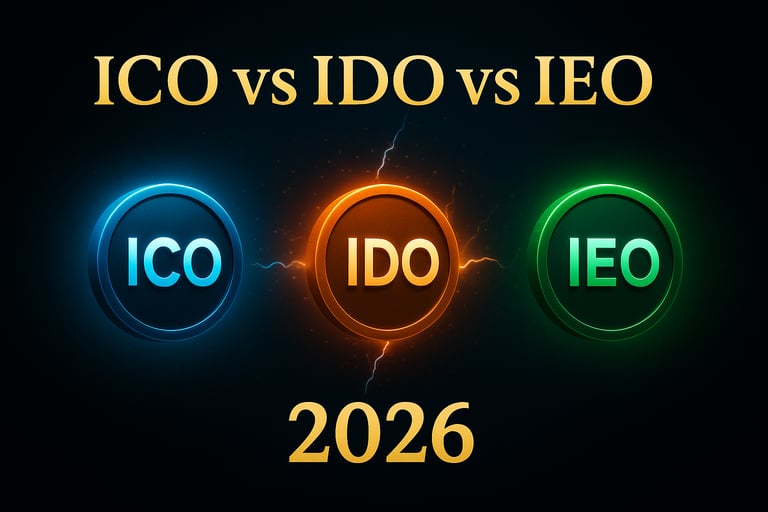Difference Between ICO, IDO, and IEO in 2026 — Where Should You Invest DropFinder Analysis
Discover the difference between ICOs, IDOs, and IEOs in 2026 and learn where you should invest for maximum profit. DropFinder Analysis explains how each fundraising model works, their benefits, risks, and where the next 1000× crypto opportunities could emerge.
ICO
11/10/20254 min read
Introduction: The New Era of Crypto Fundraising
Every crypto cycle transforms the way projects raise money and how investors discover early gems. In the early days, ICOs (Initial Coin Offerings) made headlines for minting millionaires overnight. Then came IEOs (Initial Exchange Offerings), bringing centralized trust and investor protection. When DeFi exploded in 2020, IDOs (Initial DEX Offerings) added decentralization and transparency to the mix.
As we step into 2026, all three models still exist — but they serve very different kinds of investors. Some prioritize safety and regulation, while others chase massive early gains.
This DropFinder Analysis breaks down the difference between ICOs, IDOs, and IEOs, explaining how each works, their risk levels, and where smart investors should focus their capital for 2026.
1. What Is an ICO (Initial Coin Offering)?
The ICO is where it all began — the original method for blockchain startups to raise capital directly from the public. It’s simple: a project creates a token, offers it for sale before launch, and rewards early backers with low prices that could multiply once the token lists.
How It Works
The project publishes a whitepaper outlining goals, tokenomics, and roadmap.
Investors contribute using cryptocurrencies like ETH, BTC, or USDT.
Tokens are distributed after the ICO or mainnet launch.
The token eventually lists on public exchanges.
Advantages
Early access to projects before listings.
Maximum upside potential if the project succeeds.
Open to everyone — no exchanges or intermediaries needed.
Disadvantages
High risk of failure or scams.
No guaranteed liquidity or exchange listing.
Regulatory uncertainty in some countries.
In 2026, ICOs are far more secure than in 2017. KYC verification, smart contract audits, and escrowed funds have made them more reliable. Yet, ICOs remain the most aggressive investment option — suited for risk-takers aiming for early exposure and high rewards.
2. What Is an IDO (Initial DEX Offering)?
The IDO evolved from the ICO model by moving the fundraising process onto Decentralized Exchanges (DEXs). Instead of sending crypto to a private wallet, investors join a transparent sale directly on-chain using smart contracts.
This makes IDOs faster, fairer, and more community-driven — a perfect fit for DeFi and Web3.
How It Works
The project applies to a DEX launchpad.
Approved investors connect wallets like MetaMask to participate.
Tokens are sold automatically using smart contracts.
The token lists instantly on the same DEX, creating immediate liquidity.
Advantages
Decentralized and transparent: no intermediaries.
Instant trading: investors can sell or hold immediately.
Fair participation: whitelisting and allocation rules prevent whale dominance.
Low cost: cheaper and faster for projects to launch.
Disadvantages
Volatility: early trading can cause big price swings.
Quality variance: not all launchpads vet projects deeply.
Bot issues: some IDOs suffer from automated buying scripts.
In 2026, IDOs have become the preferred method for innovative Web3 projects. They combine decentralization with accessibility, attracting investors who value both fairness and freedom.
DropFinder Analysis shows a strong surge in IDO participation since 2025, with many AI, GameFi, and DeFi projects favoring decentralized launchpads over centralized exchanges.
3. What Is an IEO (Initial Exchange Offering)?
The IEO is a token sale hosted by a centralized exchange (CEX) like Binance, OKX, or KuCoin. Unlike ICOs or IDOs, where the project runs the sale, in an IEO the exchange handles the process, including investor verification, marketing, and distribution.
Because the exchange’s reputation is on the line, IEOs tend to attract more legitimate projects and institutional investors.
How It Works
The project partners with a centralized exchange.
The exchange audits and approves the project for its launchpad.
Investors use their exchange accounts to participate.
Tokens are distributed automatically, and trading begins immediately.
Advantages
Trust and security: backed by the exchange’s reputation.
Instant liquidity: trading begins the moment the sale ends.
Large user base: immediate exposure to millions of traders.
Reduced scams: exchanges verify project legitimacy.
Disadvantages
High listing costs: small projects can’t always afford them.
Limited allocation: demand often exceeds available tokens.
Centralized control: investors depend on the exchange’s decisions.
In 2026, IEOs are the safest and most professional fundraising method, favored by large blockchain platforms and institutional-grade projects. Exchanges now integrate AI-based risk scoring and compliance tools, making IEOs more transparent than ever.
4. ICO vs IDO vs IEO — The Key Differences
Here’s how these three fundraising models compare in 2026:
Platform Type
ICO: Direct project launch website.
IDO: Decentralized exchange or launchpad.
IEO: Centralized exchange platform.
Security & Regulation
ICO: Least regulated, highest risk.
IDO: Smart contract-based, moderate regulation.
IEO: Fully vetted, exchange-regulated.
Liquidity
ICO: Depends on later listing.
IDO: Instant liquidity after sale.
IEO: Immediate trading on exchange.
Accessibility
ICO: Global and permissionless.
IDO: Wallet connection and whitelist required.
IEO: Requires verified exchange account.
Profit Potential
ICO: Highest potential, highest risk.
IDO: Balanced risk and reward.
IEO: Stable and secure growth.
Each has its place in the market, and choosing between them depends on your investment strategy and risk tolerance.
5. How the Fundraising Landscape Has Evolved by 2026
Crypto fundraising in 2026 looks more advanced and structured than ever before.
1. Regulation and Compliance
Governments now enforce clearer rules for token sales, requiring project transparency, identity verification, and audited smart contracts.
2. Multi-Chain Integration
Projects launch simultaneously on multiple blockchains like Solana, Arbitrum, and Base, attracting diverse communities and liquidity pools.
3. DAO-Driven Oversight
Communities vote on which projects launch on certain IDO platforms, ensuring collective screening and reducing scams.
4. AI Risk Analysis
AI tools are now standard in both IEOs and IDOs, helping detect suspicious wallet activity or unsustainable tokenomics before the sale even begins.
6. Where Should You Invest in 2026?
ICOs — For High-Risk, High-Reward Seekers
ICOs offer the most explosive upside potential. If you invest early in a strong project, gains can be astronomical — but the risk of failure is equally high.
Best for: Experienced investors who can evaluate projects deeply.
IDOs — For DeFi and Decentralization Enthusiasts
IDOs are perfect for those who value transparency and fairness. They provide instant liquidity and direct wallet participation, striking a balance between safety and opportunity.
Best for: Medium-risk investors and Web3-native users.
IEOs — For Safety-Focused Investors
IEOs are ideal for those who prioritize trust, stability, and ease of access. While entry prices are often higher, they provide security and verified legitimacy.
Best for: Conservative investors and long-term holders.
7. The 2026 Trend — Hybrid Launches
The next evolution in fundraising is the hybrid model, where projects combine multiple approaches.
For example:
Private ICO for seed investors.
IDO for community and early users.
IEO for mainstream exposure and liquidity.
This approach maximizes reach, credibility, and market momentum. Hybrid fundraising is expected to dominate 2026–2027 as both investors and projects seek balanced solutions.
8. The Future Beyond 2026
The next phase of crypto fundraising will integrate:
AI-based investor matching systems.
Decentralized compliance using on-chain KYC NFTs.
Multi-chain automated liquidity deployment.
Smart vesting and anti-dump mechanisms.
These innovations will make future launches safer, smarter, and more globally accessible.
Conclusion
By 2026, ICOs, IDOs, and IEOs have matured into powerful, distinct fundraising tools. Each caters to different investor profiles — from early risk-takers to cautious long-term holders.
If your goal is maximum upside, ICOs still hold the edge.
If you want transparency and speed, IDOs are the sweet spot.
And if you value security and simplicity, IEOs remain the safest bet.
The future of investing in new crypto projects lies in understanding how these models work together. The key isn’t choosing one — it’s diversifying intelligently across all three, guided by timing, narrative, and conviction.




